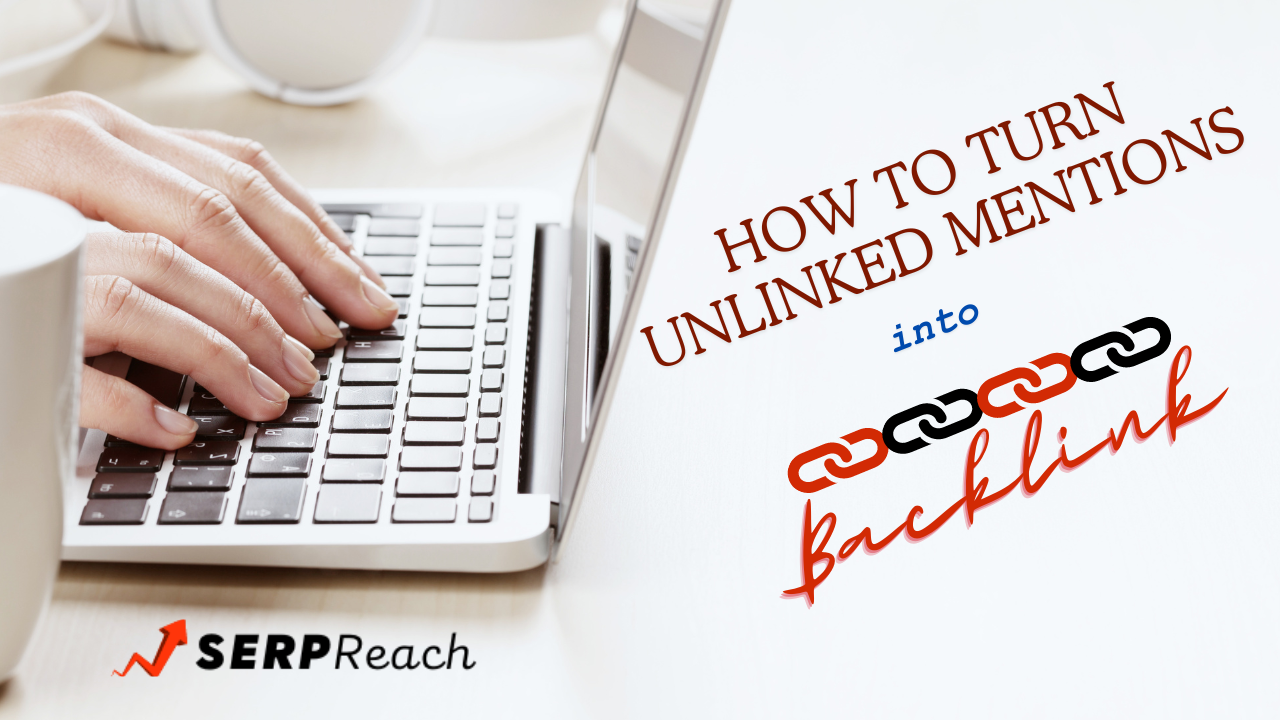To exploit unlinked backlinks, you must first find your unlinked mentions and the email addresses of the contact persons. Then, you’ll send a pitch. This article will guide you through the process.
Link building is challenging. It’ll take up your time and resources.
By the way, did you know that a detailed campaign —especially for competitive terms— can cost up to $10K?
Now, imagine spending all that money [and time] only to get an unlinked brand mention?🤯
You’d be frustrated, right?
Well, there’s good news…
Your SEO efforts have not been wasted yet, even with an unlinked mention. You can exploit them. This article will show you how.
But before we dive into that, let’s discuss the safety of this link building technique. Is it okay to chase unlinked mentions?
Should You Chase Unlinked Mentions?
In a period where websites are getting deindexed in mass, it’s okay to be wary of testing any link building tactic. It’s okay that you don’t want to lose your site like the person below.

However, unlinked mentions are not spammy. Besides, SEOs use them as a white hat link building strategy.
According to AIRA‘s “State of Link Building” and uSERP‘s “State of Backlinks,” unlinked brand mentions are goldmines for SEOs.
FYI: both studies surveyed 1027 SEOs [AIRA – 270, uSERP – 800].
Interestingly, it [chasing brand mentions] is only behind digital PR and content marketing in the best link building techniques survey.
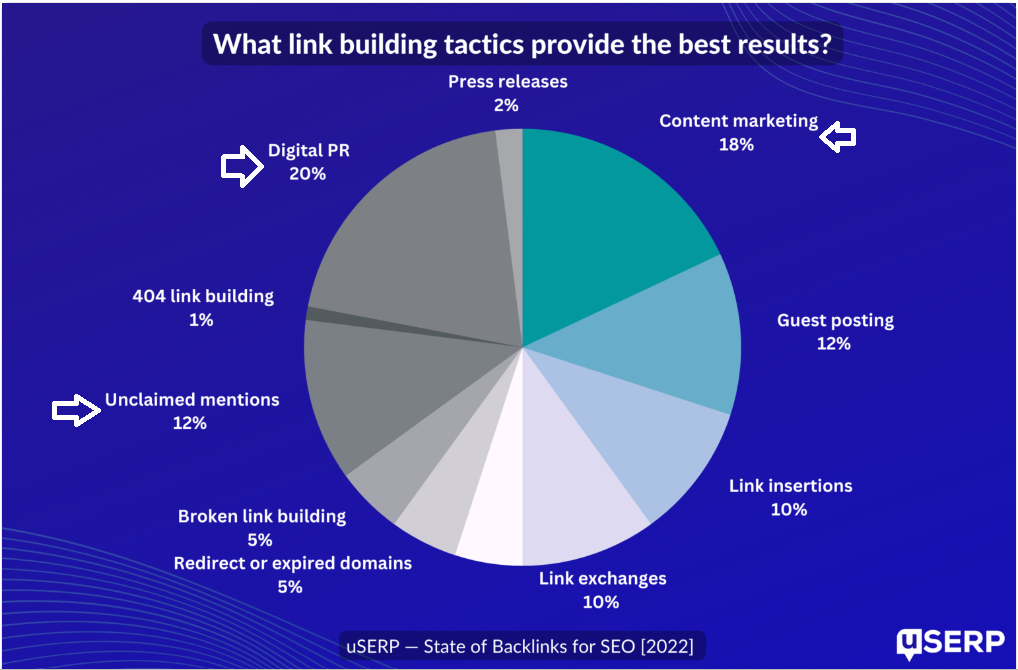
Bottom line:
Chasing unlinked mentions is 100% safe. So, yes, add it to your arsenal of backlink building strategies.
That said, let’s dive straight into chasing unlinked mentions into backlinks. We’ll do it in three parts:
- Finding brand mentions
- Finding unlinked brand mentions
- Converting unlinked mentions to backlinks
How to Find Brand Mentions
The umbrella method is either to use:
- Google [manually], or
- Third-party SEO tools like Ahrefs
But I prefer simplifying how [and where] you can use the methods. As such, I’ll discuss five different ways to find unlinked brand mentions.
- Google search operators
- Ahrefs content explorer
- Misspelled names
- Twitter profile
- Image credits
Google Search Operators
Like you use Google to ask questions, locate local businesses, and check a site’s indexed pages, it can also help find brand mentions.
However, unlike typical searches, finding mentions with Google requires strings of words and symbols called search operators.
Here is an example:
Scenario: I want to find all the mentions of Ahrefs in review articles.
- I’ll go to Google
- Then, I’ll type in this search operator, <intitle:ahrefs+review>
The result:
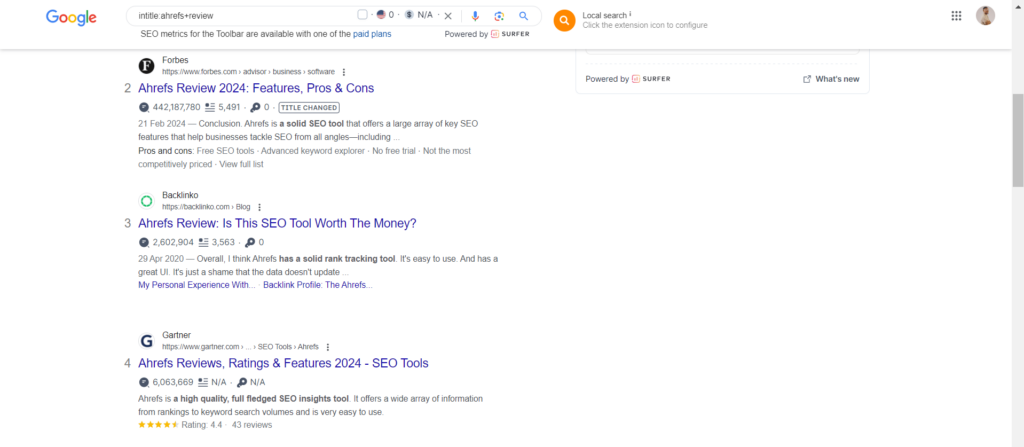
Check out more search operators and their use cases below.
Quick Note: I will use Ahrefs for my use cases. You can swap with your brand name while trying it out.
Blog Post Mentions
One of the many places to search for unlinked mentions is within blog posts. Unfortunately, there are millions of them.
According to Radoslav Chakarov’s research [as seen on Web Tribunal], 2.75M blogs are published daily on WordPress alone. Imagine having to go through all that to track your mentions.
Stressful, huh?
Well, there’s a shortcut…
Use this search operator:
“Brand name” –site:domain.com/blog
📌Use case:
- Go to Google Search
- Type in this string “ahrefs” –site:hubspot.com/blog
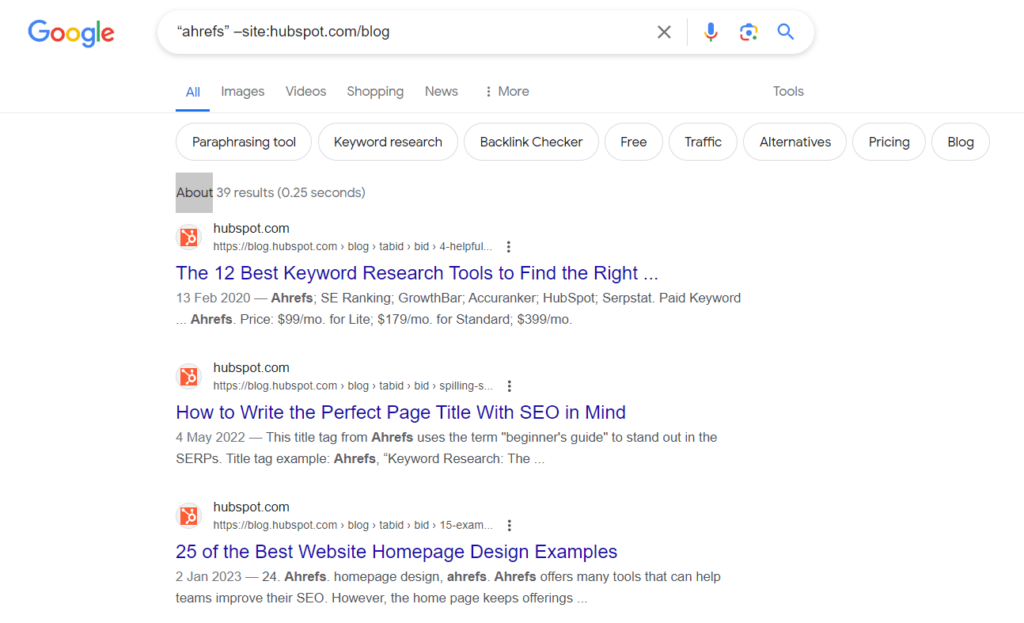
TLD-Specific Mentions
Beyond chasing blog-specific mentions, you can search for unlinked mentions on specific Top Level Domains (TLDs). TLDs are the last segment of a domain name.
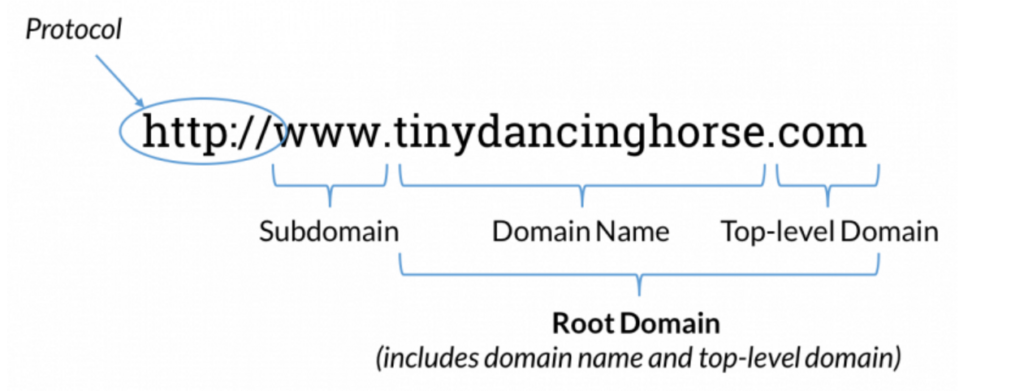
While there are several TLDs, I recommend using .com, .org, .edu, and .net, as they are authoritative.
Note:
There are other authoritative TLDs. But I’ve gotten great results from the ones mentioned above.
The bottom line is finding authoritative TLDs related to your niche and location.
That said, here is how to find TLD-specific mentions:
- Use this search operator, “Brand name” + site:.org
📌Use case:
- Go to Google Search
- Type in this string “ahrefs” + site:.org
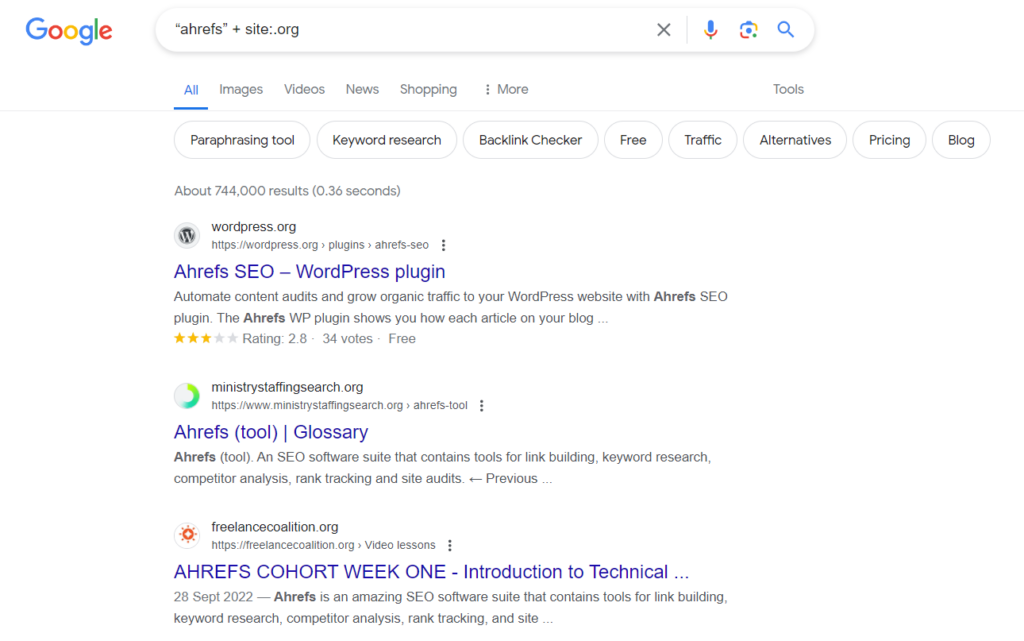
Social Media Mentions
You can monitor social media posts to find unlinked brand mentions. However, this can be challenging because of daily social media posts.
For instance, according to Daily Tweet statistics, 500 million tweets are shared daily. Obviously, you cannot go through all these tweets to find your brand mentions. That is hectic!
What should you do?
- Use this search operator, intext:brand name site:twitter.com
📌Use case:
- Go to Google Search
- Type in this string intext:ahrefs site:twitter.com
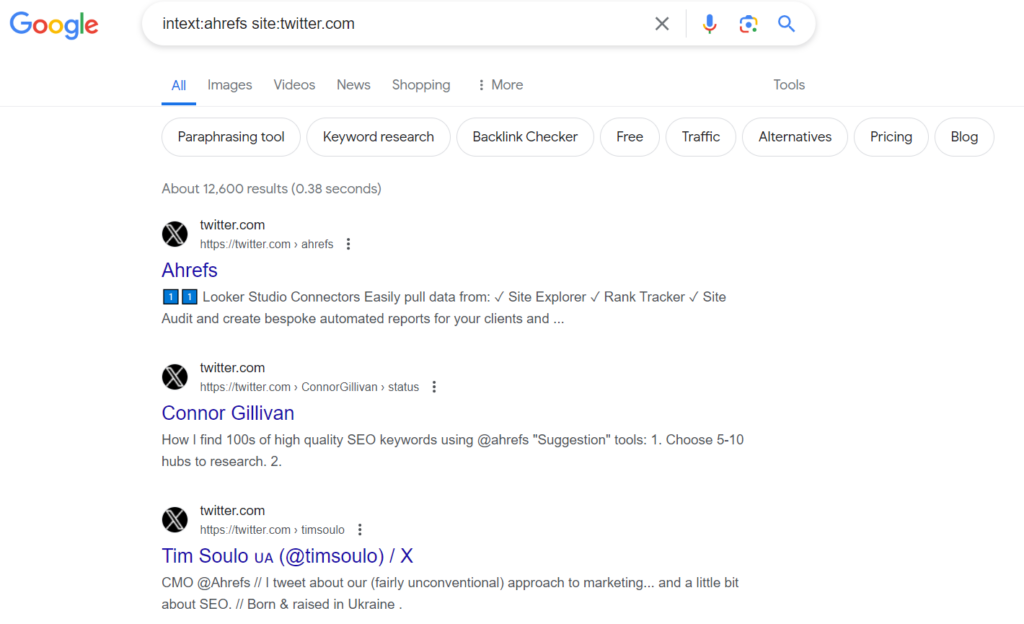
Did you notice that some results are tweets from Ahrefs or its employees/brand advocates? I don’t need to see these results because they are internal mentions.
Therefore, to focus on external mentions, this is what you should do:
- Use this search operator, intext:brand name site:twitter.com -”unwanted keywords”
📌Use case:
- Go to Google Search
- Type in this string intext: ahrefs site:twitter.com -“tim soulo”
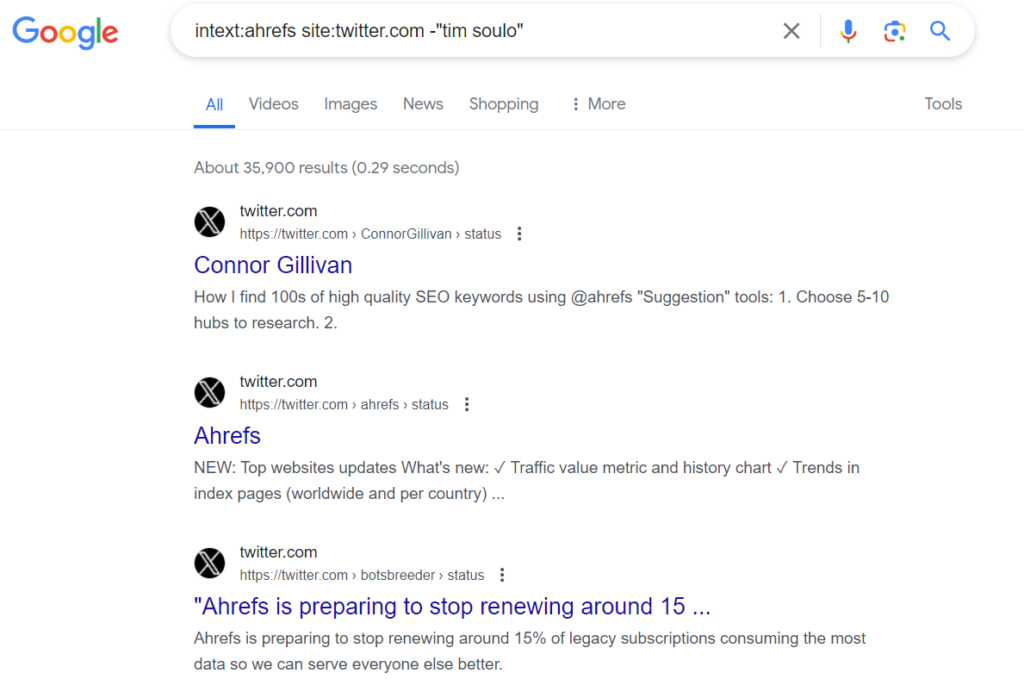
Mentions in Listicles
Like any other methods mentioned above, finding your brand name in listicles on Google search is easy.
You only need to conduct regular Google searches with your brand name within topics relevant to your niche.
Use this search operator, “brand name” “relevant topic”
📌Use case:
Go to Google Search
Type in this string “ahrefs” “helpful SEO tools”
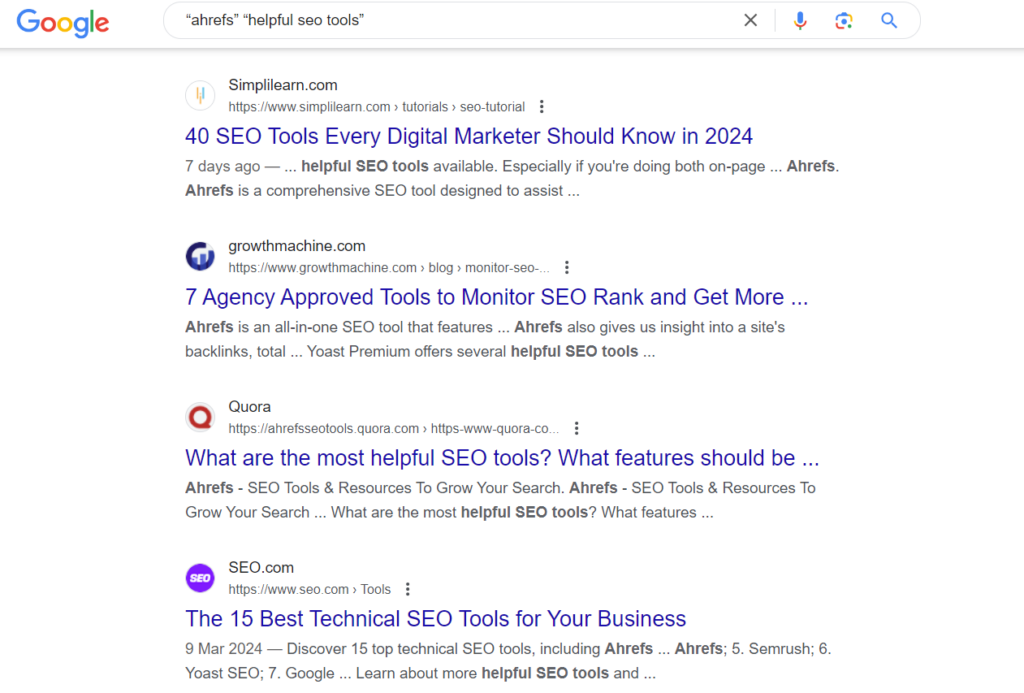
Mentions in Press Releases
Press releases that announce essential information about a brand are published often.
However, I’ve noticed that PR companies mention many brands without linking to them.
So, for your brand to be well-referenced, you must find these press releases.
But how do you find them?
Use this search operator, “announced” “brand name” –press –release
📌Use case:
Go to Google Search
Type in this string “announced” “ahrefs” –press –release
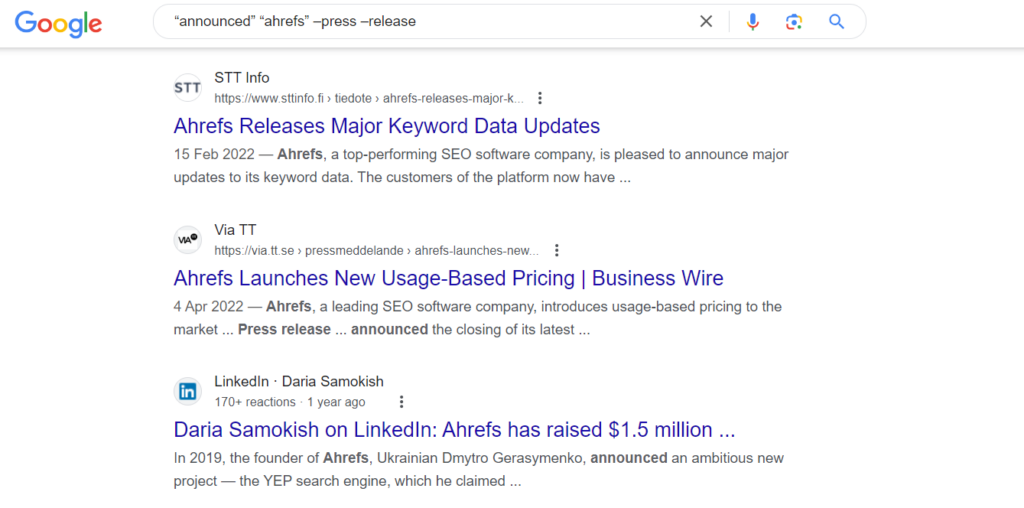
Ahrefs Content Explorer
Google searches can be too broad. Plus, the process is hectic, especially the data extraction part.
The good news is that the Ahrefs Content Explorer is an easy-to-use alternative. It is like a mini search engine. And it also helps that Ahrefs has one of the most robust databases [after Google].
In essence, you can trust the Content Explorer.
Moving forward to how to use the Content Explorer…
Like in Google search, you’ll need search operators. But the case is different here. The strings are less complicated.
More importantly, you can filter your search by crucial metrics such as organic traffic or domain rating.
Here is an example:
Scenario: I want to see all the mentions of Ahrefs on sites [excluding the Ahrefs’ domain] with at least 1K “website traffic” and 50 “page traffic” monthly.
- I’ll go to Ahrefs > Content Explorer
- Then, I’ll type in this search operator, <“ahrefs” -site:ahrefs.com>
- Click more filters; add “page traffic” and “website traffic.” Set the least value to 50 and 1000, respectively.
The result:
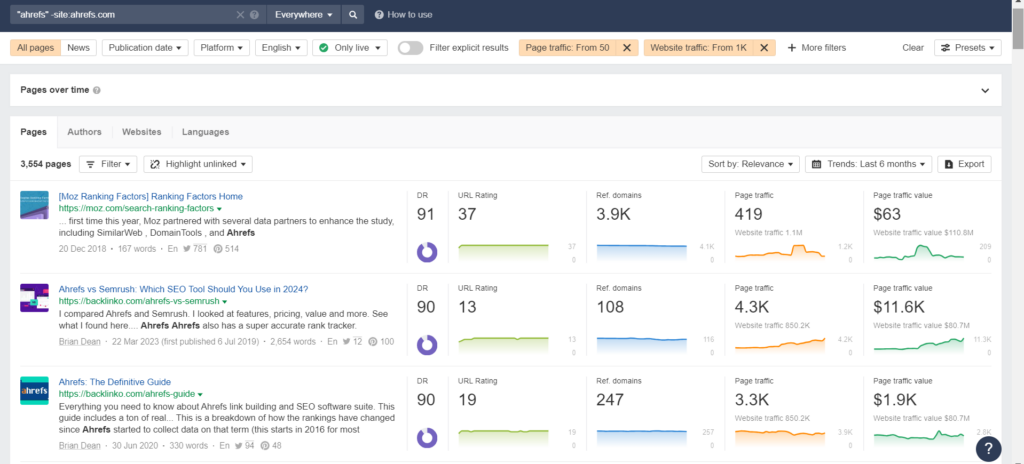
Misspelled Names
Though rare, I’ve seen cases where link building campaigns have been successful and yet futile. How?
The target page mentioned your brand name and sent a link to your site.
Unfortunately, the site targeted is not yours. It was a misspelling in the URL.
Imagine a domain/brand name like “Legiit,” for example. Unless it was spelled out, most people would write it as “Legit.” Hence, the links will be off.
That said, how can you find the mentions of domains misspelled?
- First, compile a list of the possible misspellings
- Go to Domain Typo Generator > type in your brand name > check all the “typo options” boxes
- Look at the results under Typos and copy them to your clipboard
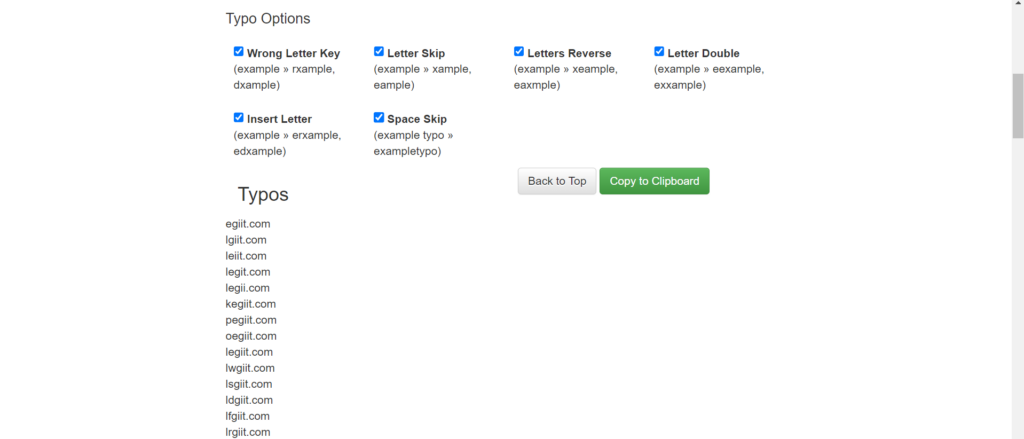
- Verify that the suggestions are what people link to
- Go to Ahrefs > More > Batch Analysis > paste the copied URL from Domain Typo Generator
Note: you are limited to 200 URLs at once.
- Now, sort the results by referring domains to weed out nonsensical suggestions.
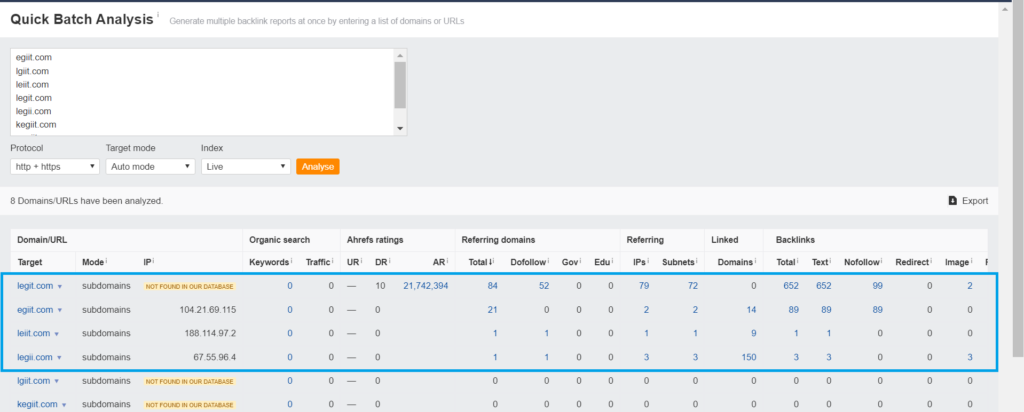
- Lastly, confirm if the backlinks to the sites are mistakes.
- Pick the domains with at least one referring domain > enter the URL into Site Explorer.
- “Legit.com,” for example, is a legit site. It is not a misspelling. I arrived at this conclusion based on the anchor and nature of the referring pages.
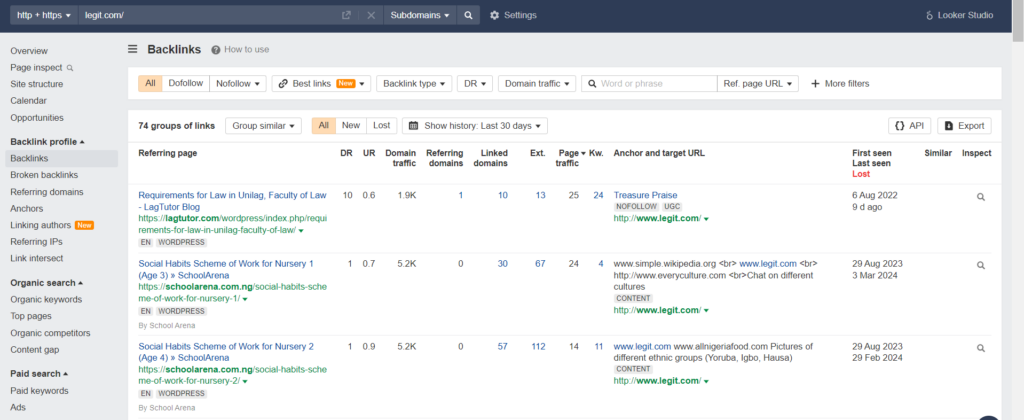
- You can never be too sure. So, do a final check. Click more filters > backlink > anchor. Then, type in the original spelling you’re looking for.
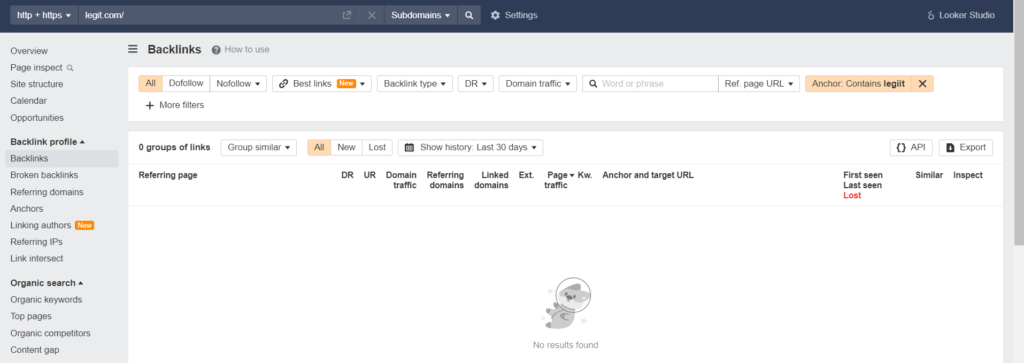
Note:
In our example, there are no unlinked mentions due to misspelled URLs, but your website might have. So, check it.
Twitter Profile
While social profile link building is a thing, there might be accidents. A linking site might mistakenly link to your Twitter profile instead of your actual site.
How does this grave mistake happen?
Blame it on Google Docs and its hyperlink suggestions
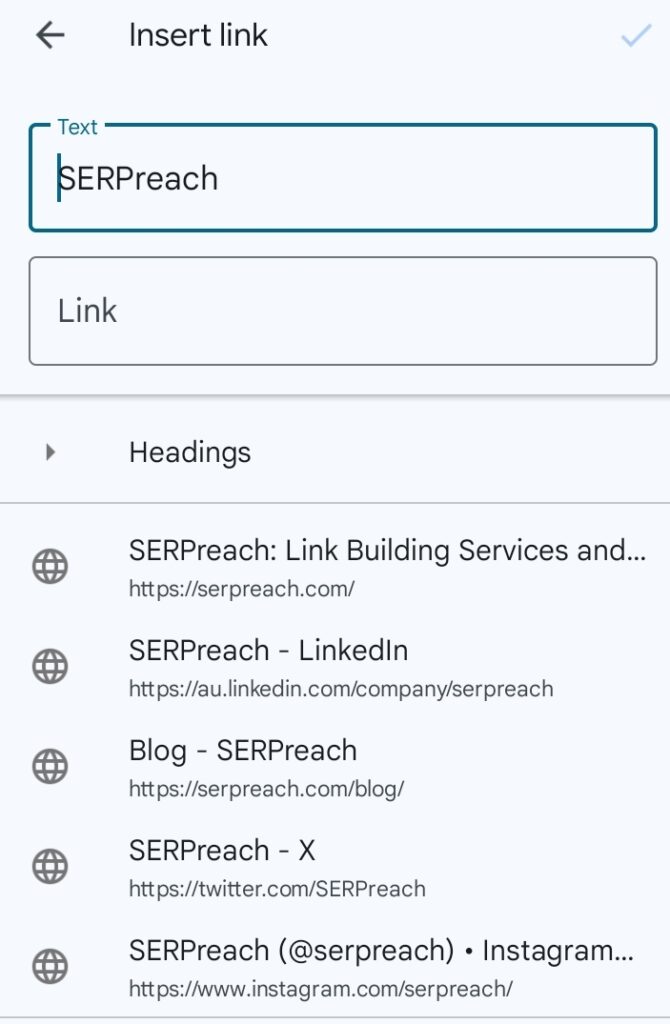
Note: not all Twitter profile links are mistakes. Some might be intentional out of fear of Google backlash or not wanting to link to a competitor’s site.
So, how can you verify the truth?
Note:
I’ll only discuss how to find mentions generally here. The verification part will need Screaming Frog [I’ll explain how in the next section].
- Go to Ahrefs > Site Explorer > enter your Twitter profile URL
- Ensure to remove backlinks from your actual website to streamline the search
- Click “more filters” > referring domain > domain name
- Set the rule to “doesn’t contain [then your domain name]”
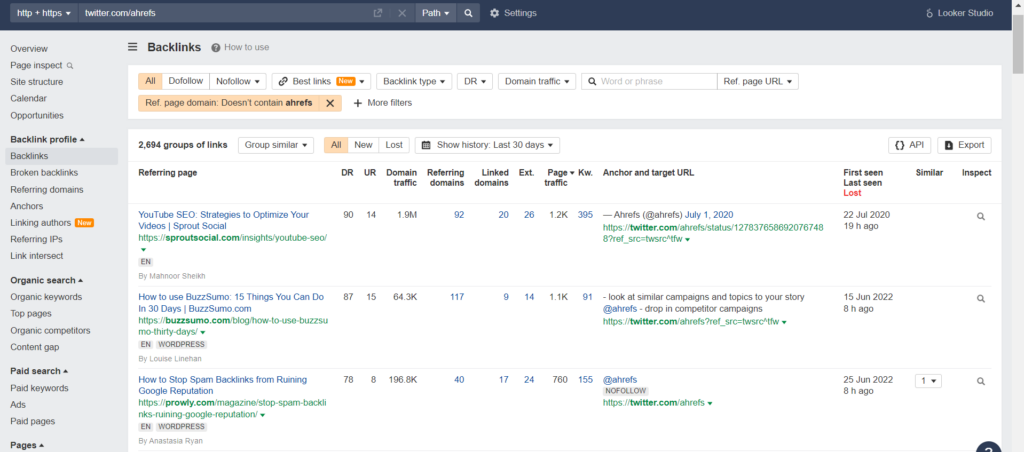
Before using Screaming Frog to confirm the unlinked mentions, you can reverse engineer your Twitter profile mentions. Ask linked pages to swap the links to your actual site.
Pro tip:
You can use this technique for other social media platforms — like Facebook, Pinterest, etc.
Image Credits
If you do all the hard work of capturing a unique picture or creating an infographic, you deserve a backlink. Unfortunately, this is not always the case.
The chances are that bloggers and creators will use your images without linking back to you. Some might mention your brand name but without a backlink.
In any case, you can still such mentions or images. How?
📌 Let’s use this practical example…
I saw an interesting infographic on SocialMediaToday about “helpful SEO content.”
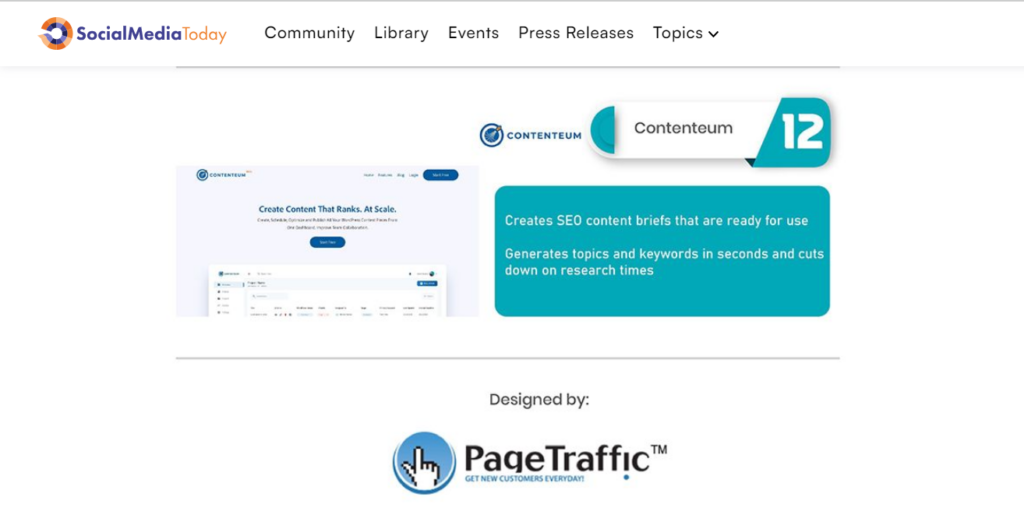
The infographic looked perfect for the content. So much so that I thought it belonged to SocialMediaToday until I saw another name at the footer.
The owner’s name [Page Traffic] is in the infographic, but no backlink.
If I were the site owner, I’d do a deep search to find other sites stealing my images and not crediting me.
Here is how to do that:
- Right-click on your image/infographic on Google Chrome > select “search image with Google
How to Find Unlinked Brand Mentions
After rounding up all your mentions, it is time to differentiate which one is linked or unlinked. For this, you need:
- Ahrefs
- Screaming Frog
Ahrefs
This method is limited to Content Explorer. Nonetheless, it is more straightforward for non-techy folks compared to using Screaming Frog.
So, how is it done?
Go back to our Content Explorer example:
- Type this <“ahrefs” -site:ahrefs.com> into Content Explorer
- Click more filters; add “page traffic” and “website traffic.” Set the least value to 50 and 1000, respectively.
- Select the “highlight unlinked” in the result to reveal unlinked mentions
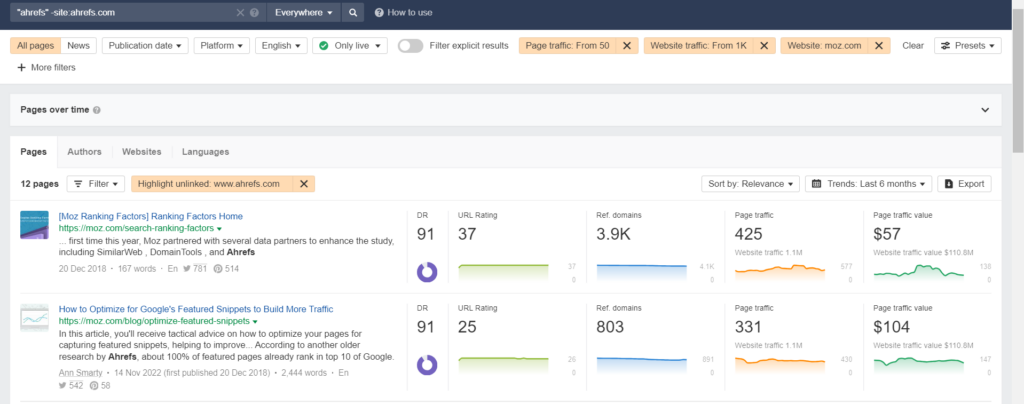
Screaming Frog
Unlike the Content Explorer method, Screaming Frog works with any of your lists. Plus, the former has its disadvantages.
For example, Moz linked to Ahrefs in one of the search results. They just didn’t use “Ahrefs” as the anchor text.

Bottom line:
Screaming Frog is a more robust and accurate tool than Content Explorer for qualifying unlinked mentions.
So, how does it work?
- Compile your list [of general mentions] from Ahrefs or Google
- Go to Screaming Frog > Configuration > Custom > Search
- Use the “does not contain” search and input this code:

- Replace “ahrefs” with your domain name. While at it, limit crawl depth to 0, and uncheck all the boxes in “configuration > spider > basic.”
How to Convert Unlinked Mentions to Backlinks
- Draw up a list
- Vet and qualify the prospects
- Get the email addresses
- Craft your pitch
- Follow-up and negotiate
Draw up a List
The first step is to find your brand mentions. You can compile them into a spreadsheet for easy access.
Depending on the tool used, you can export your results as a spreadsheet.
What if you used Google search operators?
Find a resourceful SERP scraper. It’ll compile your search result URLs into a list.
Vet and Qualify the Prospects
The vetting and qualifying process is when you confirm which mentions are unlinked. Also, this phase is where we check again if a misspelled domain is a possible link building opportunity.
Get the Email Addresses
By now, you should have qualified prospects — sites that mentioned you but without a backlink. However, knowing the sites is only half of the task required.
More than that, get the contact details of the said prospects. How?
- I’d start with the author of the content. Find their name on LinkedIn.
- Look up other essential employees in charge of content, like Content Managers and editors.
- Input the names on GetProspect or Hunter.io to get their email addresses.
Craft Your Pitch
The first and most crucial rule here is never to send generic pitches. Otherwise, your open and conversion rates will be embarrassingly low.
Note that generic pitches are not the same as having a template for your message. The latter is suitable for direction. But you also switch things up.
Overall, message each prospect individually as you would address different people at a coffee shop.
While crafting your pitch, remember to include these critical parts:
- Introduction
- Establish a relationship
- Your offer
Follow-up and Negotiate
Don’t be derailed when you send your pitch and don’t get a response from site owners. FYI, I rarely get responses in the first mail unless I have a relationship with the recipient.
In other words, sending follow-up messages is okay [and a standard practice]. And don’t worry about recipients labeling you as spam yet. Do this instead:
- Leave a space of 3-4 days before sending a pitch
- Send your pitch on active [business] hours on weekdays
- Always follow up in the same thread. This will help the recipient easily navigate to the beginning of a conversion.
- Limit your follow-ups to 3 per prospect. This will help you save time.
In the event of a successful pitch, the recipient will likely ask for something. Even if they didn’t ask, offer something to negotiate a favorable relationship.
Note:
I don’t recommend offering money as a deal sweetener. Instead, you can discount your top-selling product, provide a limited free trial, or even a backlink.
And while at it, be flexible and open to ideas. That is how to turn unlinked brand mentions to backlinks.
Additional Tips
Look Beyond Just Your Brand Name
Your business is more than just your brand name. So, don’t limit your search to it.
Chase relevant mentions of your products, services, and even ambassadors. In short, milk all the opportunities, names/ideas related to your business.
Try out Different and New Search Operators
By all means, you can [and should] use libraries to find search operators for your brand mentions. But don’t get stuck on this. Experiment, too.
Funnily enough, some of the operators in the libraries don’t work. Either way, you have to test each one and see what works. Then, document what works.
Be on the Lookout for New Unlinked Mentions
While it’s good to chase after unlinked mentions, it is better to stay ahead of such. In other words, be on the lookout specifically for new mentions on other websites.
Fortunately, tools like Google Alerts can help.

For more robust tracking, use Ahrefs Alert.
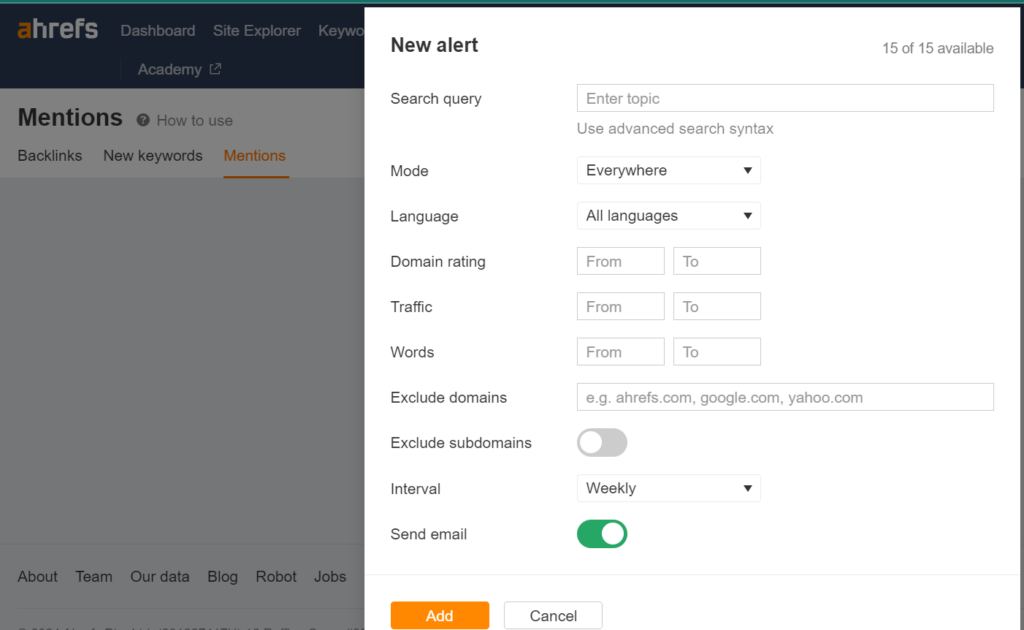
Summary
Popular or not, there will be mentions of your brand, especially if you create linkable assets. Ideally, these should earn valuable backlinks for your site. But that is not always the case. Hence, unlinked mentions.
Fortunately, claiming unlinked brand mentions is possible. Here is how:
- First, identify all your mentions with Google search operators, Google image search, or Ahrefs.
- Then, use Screaming Frog to find unlinked mentions
- Use a tool like Hunter.io or GetProspect to get the email address of the contact details of the sites
- Lastly, send your pitch and turn the brand mentions into links
Ultimately, set alerts to stay ahead of fresh mentions.
